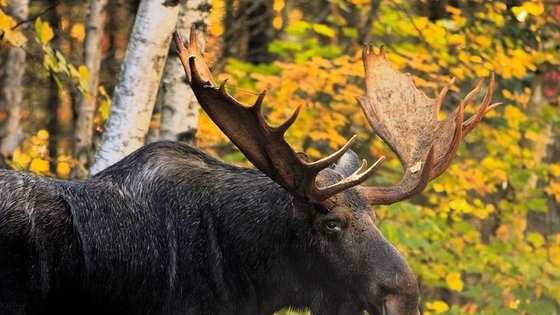Maine, New Hampshire biologists working on moose study
So far this winter, only two dead, both in Maine

With a tough winter still underway, moose biologists in Maine and New Hampshire are on the death watch.
They are working together in a five-year study to understand the declining moose populations in their respective states.
The next eight weeks of spring will prove critical with survival rates being studied of collared moose with GPS units.
Lee Kantar of Maine's Department of Inland Fisheries and Wildlife in Bangor, and Kris Rines, of the New Hampshire Fish and Game Department are collaborating in their study of what is happening in their respective states.
Maine is vast and further north than New Hampshire. It has higher densities of moose. Maine has roughly 60,000 moose compared to New Hampshire's 4,000.
They have not seen the severity of the problem facing New Hampshire's moose in the past but they, too, had a horrible year of mortality in 2014 related to ticks.
This winter has been hard on all animals, she said, because it takes more energy to stay warm. The snow makes it difficult to move in search of food.
So far this winter, Maine has lost two of its 68 collared moose, Kantar said. Both were calves. One was likely related to ticks draining her strength while a small bull's death is inconclusive.
New Hampshire has no recorded moose deaths so far this winter of its collared moose.
But it is early.
"April is the month of death for moose," Rines warned.
"So far this year, we haven't had any mortality, but our tick counts are relatively high. Another couple of months and we will have a better idea," she said.
New Hampshire had a high of about 7,000 moose in 1998 and 1999 but Rines said pressure to reduce the density because of traffic deaths account for about half the decline.
The state is now below goal for moose capacity in most regions.
A limited lottery to hunt moose is still on, but it is proposed for 104 tags in 2015, compared to a high of about 650 a decade ago.
In Maine, a proposal is to reduce the hunt slightly to a lottery with 2,815 tags, down from 3,095 in 2014, Kantar said on Monday.
Rines said she and Kantar are looking at the possibility of a moving habitat line due to weather change.
If the ticks fall on to snow, they die. But if they fall on to the cold ground, they can survive and reproduce.
Kantar said while one year, that might lead to a small adjustment, it is the cumulative effect or frequency of year after year of such problems and what that means over time to the moose population.
He said New Hampshire is "a star in terms of research on moose so we are pretty excited to do a comparative study together."
This will be the second spring of the five-year study. The two states are using the same contractor to wrangle and collar the moose from helicopter.
If the animal stops all movement for four hours, a signal goes off and the animal can be recovered for study.
The study area between the two states is abut five townships away from this state's North Country, Kantar said, and slightly north.
Moose are found only in the North. They are abundant in Scandinavia and places like Canada's Newfoundland, but declines are being noted in more southern edges of their range in places like Minnesota, Washington and Wyoming.
Kantar noted that Professor Pete Perkins at the University of New Hampshire has been a leader in moose study and that New Hampshire "has done an awesome job," studying their herd.
Rines said it will be "another couple of months" before the true picture emerges, but regardless, weather will play a big role.

